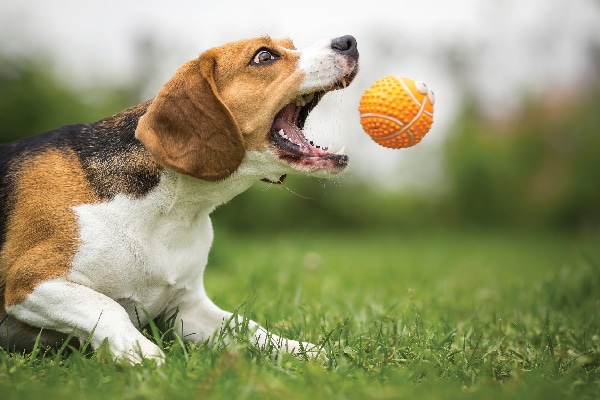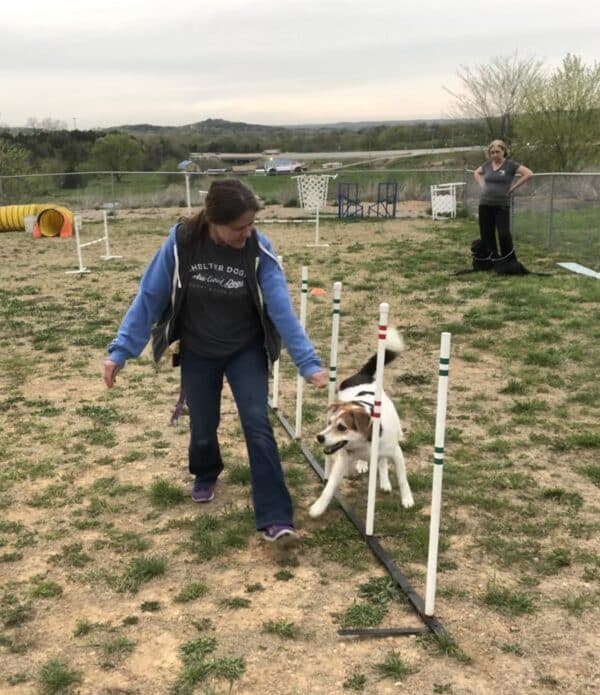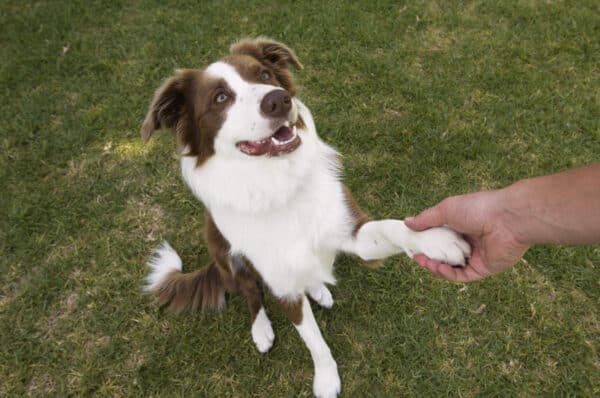True or false? All dogs LOVE to fetch! I can assure you this is false. While many dogs do love a game of fetch (and others are obsessive fetchers), many other dogs either couldn’t care less about fetching or just don’t get the game. My two Border Collies have zero interest in fetching or tugging on toys. It wasn’t important to me that they fetch, as they are monster herders and excellent, invaluable farmhands, so I wasn’t worried about their lack of desire to fetch. But what if you’re wondering how to teach your dog to fetch?
First off, beware the Google! I Googled “how to teach your dog to fetch” and got 7,300,000 responses! Yikes!
How to teach your dog to fetch — tips from the pros

While my dog snobs sneer at the idea of fetching, I have taught countless client dogs to love it. One reason there are millions of suggested ways for how to teach your dog to fetch on the internet is because there are many ways to teach a solid fetch. I’ll share some of my preferred, effective methods for how to teach your dog to fetch below.
1. Remember that fetch should be fun for your dog.
This is the most important rule when it comes to how to teach your dog to fetch! It makes no sense to teach a fun game in a not fun or a painful manner. Dropping the retrieved object was once trained via pain, but thankfully we are (hopefully) long past those days.
2. Start training with the end in mind.
At first glance, it would seem that the final thing a dog does before you begin the game again is to hand you the ball, Frisbee, toy or whatever object you threw for her to retrieve. There is actually a step that must happen even further back: A dog needs to love to play with objects and put them in her mouth to begin with. I love to start with puppies when I have that option — you can train older dogs as well, but puppy brains are formative and open to shaping new experiences.
I begin teaching toy love by putting a wide variety of toys out of the dog’s reach in an enclosed space to limit distractions. Some toys squeak, some have feathers, some are tied to a string, some bounce, some roll, etc. I train in very short bursts as I work to find which toy is the dog’s favorite. I’ll start, say, with a dog ball and bounce it on the ground while talking excitedly to the dog. If the dog engages or seems interested, I mark that interest with “Yes” and toss the item to the dog. For the moment, I am not concerned that I get that toy back — that comes later.
The dog may very well sniff it and walk away. No problem. I go on to the next toy. If the dog shows zero interest after I try out several of the toys, I stop the session and try again later in the day. For those dogs who may be scared of toys or who just couldn’t care less, I have smeared cream cheese or peanut butter on the underside of the toy to begin getting interest. Once I have a dog interested in toys, I move on to the next step.
3. Teach the dog how to release the toy.
Now that the dog has laser beam focus and interest in toys, the next step in how to teach your dog to fetch is to teach her how to release that toy, preferably into our hand. One simple way to teach this is to hold out your hand under the dog’s chin as she has the toy in her grip.
Hold a smelly meat treat near your dog’s nose. Mark it with an enthusiastic “Yes” when she drops the toy to get the treat — then, of course, give her the treat. Pick up the toy and repeat, repeat, repeat. Once your dog is dropping the ball regularly, add a cue such as “Drop” or “Give.”
It does no one any good to stand above a dog and repeat a cue that is new to her. You are literally speaking a foreign language to her.
4. Get your dog to chase a toy.
After building interest in toys and teaching your dog to give you back a toy, next work on getting your dog to chase a thrown object. You can simply toss a ball a few feet from you and encourage your dog to get it. If she does, praise and take a few energized steps backward, away from your dog so she is coming toward you with the toy in her mouth. Make it super fun! Gradually extend the distance you toss the ball as well as the distance you step back away from your dog as she’s running back to you. You could also work with a second person and toss the ball back and forth and get your dog excited about chasing the moving object. Reward her with that toy now and again so she doesn’t get frustrated.
More quick tips for how to teach your dog to fetch successfully:
- Work first in a small, enclosed space to limit your dog’s distractions.
- Work indoors in a familiar setting, so tempting new smells don’t pull your dog’s focus elsewhere.
- Have fun teaching interest in toys, then fetch.
- Work in very short sessions, so your dog wants to play the game again and again.
- If you’re getting nowhere with fetch, go back to the point where your dog understood and was engaged, and start again from there.
The bottom line on how to teach your dog to fetch

Fetching is a wonderful, shared game between two species, assuming that both dog and human have an interest and find big joy in this particular game. Just remember that dogs and puppies don’t arrive on the planet understanding this game — you have to know how to teach your dog to fetch.
Thumbnail: Photography ©Lunja | Getty Images.
About the author
Annie Phenix, CPDT-KA, is a professional dog trainer based in Utah. She is a force-free trainer specializing in working with troubled dogs. She is the author of The Midnight Dog Walkers: Positive Training and Practical Advice for Living With a Reactive or Aggressive Dog. For more information, visit phenixdogs.com.
Editor’s note: This article first appeared in Dogster magazine. Have you seen the new Dogster print magazine in stores? Or in the waiting room of your vet’s office? Subscribe now to get Dogster magazine delivered straight to you!





